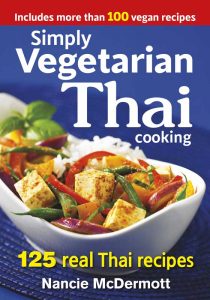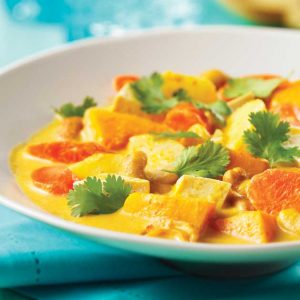 I’m sitting at the Association of Food Journalists conference in Phoenix when a woman plops down beside me, gives me a megawatt smile, and with that potent Southern mix of charm, confidence and purpose says, “Hi. Nancie McDermott. North Carolina.”
I’m sitting at the Association of Food Journalists conference in Phoenix when a woman plops down beside me, gives me a megawatt smile, and with that potent Southern mix of charm, confidence and purpose says, “Hi. Nancie McDermott. North Carolina.”
As if she needs to introduce herself. As if she hasn’t published 14 cookbooks including her newest, Fruit: A Savor the South Cookbook. As if she and fellow James Beard award winner Andrea Nguyen hadn’t just walked off the stage after their cookbook success presentation. As if I wasn’t already a slobbering fan.
Nancie offer solid, doable recipes enriched by her respect for authentic foodways, whether the cuisine is of the American South or Southeast Asia (she did a Peace Corps stint in Thailand). Nancie and I share a love for culinary back stories, how culture, place and season inform each dish. She serves it all up with a generousness of spirit that’s pure Nancie in her books, her classes, her demos, her talks and, happily for you and me, here. When I invited/begged her to be my Ms. October for My Favorite People, My Favorite Recipes, she shot back with a cheer-filled email, a warming Thai curry recipe perfect for autumn and a guest post that makes me desperate to get in the kitchen and cook with her. Until I can find a way to make that happen, I’m thrilled share her recipe and post, bright with the flavors of Thailand and the spirit of Nancie.
True Thai Curry with a Side of Inspiration
After three years living in Thailand as a Peace Corps volunteer, I came back home to the USA with a need and expectation that Thai food would remain part of my life forevermore. Not that I had prepared myself to address this need — I was in my mid-twenties, and operated on impulse and passion more than thoughtful planning. Lucky for me, the quintessential Thai dish known in English as “curry” is one of the simplest to cook at home, even for a former PCV settling back in to life in Greensboro, North Carolina.Settled in an apartment and working as a middle-school English and Social Studies teacher, i looked in the Yellow Pages (this was a long time ago, kids; Google “yellow pages” if you need details) and found a listing for The Oriental Store. It was a small, family-owned Asian grocery store in a strip mall, run by a Korean family and focused on East Asian ingredients more so than Southeast Asian. But they had everything I really needed to make a basic Thai meal: Jasmine rice; canned unsweetened coconut milk; palm sugar; dried slices of galanga for soups; tamarind pulp for sauces, and most important of all, Thai curry pastes in small cans. The brand was Mae Sri, and they carried four types: Red; Green; Yellow; and Mussamun, the most popular Thai curries.
I knew how to cook rice, and I had a basic familiarity with simple Thai dishes, enough to use the instructions on the curry paste can and an English language cookbook purchased just before I left, to try my hand at Thai cooking in my new-old home of North Carolina.
The shop carried kabocha pumpkins, popular with both East Asian and Southeast Asian cooks, and a big favorite in Thai curries. I heated up some of the canned coconut milk until it released its sweet aroma and thickened a little. Then I added the canned red curry paste, a wet, rusty-red flavor-packed paste made of garlic, shallots, dried red chili peppers soaked until soft, toasted cumin and coriander seeds and peppercorns pounded to a fragrant and delicious seasoning powder, and Southeast Asian herbs including lemongrass, wild lime peel, and galangal, a first cousin of ginger with an edgier citrusy bite. Once the paste dissolved into the coconut milk, I added tofu, peeled kabocha pumpkin chunks, mushrooms, palm sugar, and seasonings and simmered until everything was tender. With a plateful of jasmine rice, a platter of stir-fried spinach and a bowl of quick-pickled cucumbers, my basic Thai meal plan was set.
Ever since I’ve varied the types of curry pastes, the main ingredients, and explored the ever-growing abundance of Southeast Asian ingredients, both shelf-stable and fresh, sold in Asian markets as before, but nowadays also in supermarkets and farmers’ markets as well as via online sources such as www.importfood.com. Today I can find once-rare vegetables such as golf-ball sized Thai eggplants and long beans, herbs including Asian basil, lemongrass, lime leaves, turmeric, galangal, and fresh superhot Thai chilies. I start the rice, get the curry going, and when both are simmering away, i tend to accompaniments such as a simple salad or a garlicky stir-fry using tender greens or tiny bok-choy.
Curries like this cashew-studded winter-vegetable dish work wonderfully on busy weeknights and for take-along contributions to potlucky gatherings, with the heat dialed up or down depending on how much curry paste I add. Like all stews, Thai curries improve as they stand, so last night’s curry over rice makes for a lunch to anticipate through a busy morning’s tasks.
I learned to love rice during my time in Thailand, where it anchors the meal in a very distinct way, unlike the composition of Western meals. Thai people eat rice and things to go along with it, not a main dish with sides and some bread to fill out the menu. Plain, unseasoned long grain rice is still my favorite foundation for a curry-centered meal, but once I’d been back home long enough to open my perspective on what Thai food is, I decided that Thai curries go wonderfully with all kinds of grains, from barley and quinoa to farro, bulgur wheat and couscous. Rice noodles or angel hair pasta work well, too.
I love making Thai curry pastes from scratch, when it’s a DIY cooking project kind of weekend day, but for my kitchen rotation, curries like this one keep me cooking extraordinary food without extraordinary effort, no matter how my day went. With a rice cooker and Instant Pot to get the grains going, and a supply of canned curry pastes and coconut milk in the pantry, I am ready to make curries like this just as easily as I can put a pasta supper on the table. I can make the most of seasonal produce (summer squash, peppers, Asian eggplant, zucchini, spring peas and asparagus when the weather gets warm and the garden starts showing off; pumpkins, parsnips, potatoes, and carrots when it’s dark early and I want things to simmer a while to warm up the kitchen.
I hope this recipe gives you ideas and inspiration beyond the details I wrote on the page. Thai people love vegetables and enjoy every ingredient for its own strengths. Think green unripe papaya shredded and pounded up into the Northeastern-Thai salad known as som tum; while the same papaya left on the tree for a while longer ripens to sweet perfection, turns golden, and makes a fabulous fruit course brightened with a squeeze of lime. Here’s hoping my recipe provides you with a tasty meal and a side of inspiration on how you can bring vibrant Thai flavors to you everyday cooking, whether you’re hurrying to get supper on the table or daydreaming about how to make a special event menu sparkle with the genius flavors of Thailand’s vibrant cuisine.



Leave a Reply